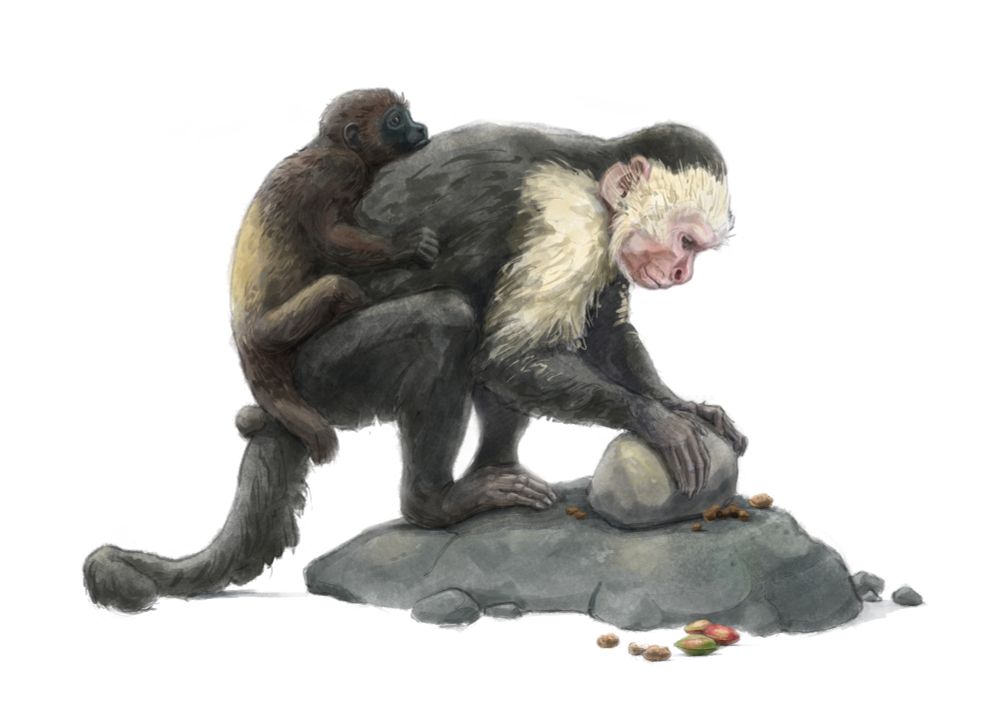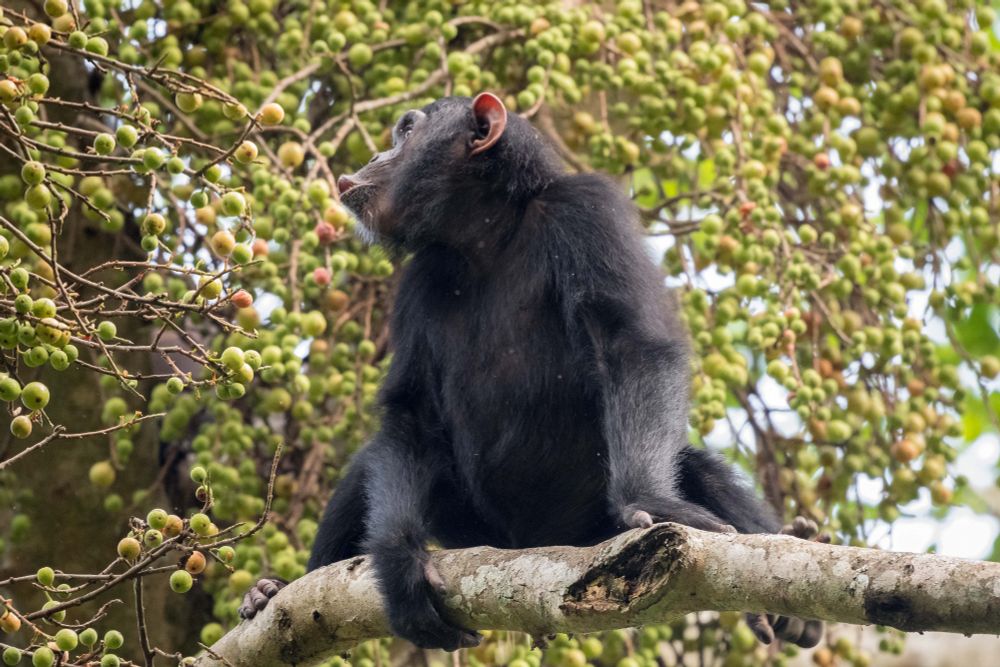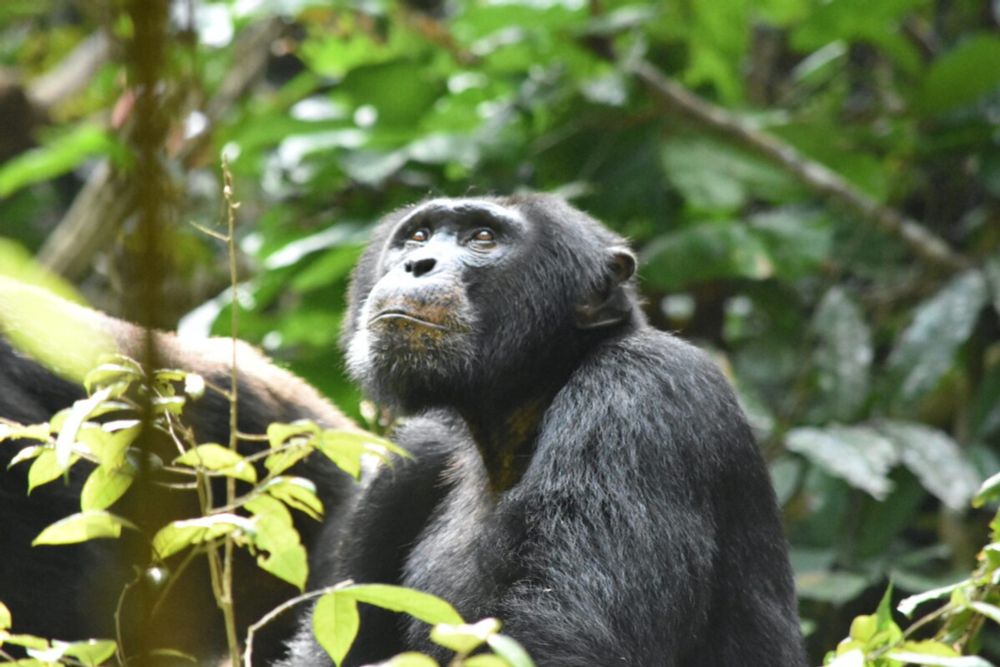
Oscar Nodé-Langlois
@oscarnl.bsky.social
PhD in neurosciences. Studying social learning in wild chimpanzees. Interested in ethology and visual arts.
Reposted by Oscar Nodé-Langlois
💙New paper!💙
How is knowledge transmitted across generations in a foraging society?
With @danielredhead.bsky.social
we found: In BaYaka foragers, long-term skills pass in smaller, sparser networks, while short-term food info circulates broadly & reciprocally
academic.oup.com/pnasnexus/ar...
How is knowledge transmitted across generations in a foraging society?
With @danielredhead.bsky.social
we found: In BaYaka foragers, long-term skills pass in smaller, sparser networks, while short-term food info circulates broadly & reciprocally
academic.oup.com/pnasnexus/ar...

Transmission networks of long-term and short-term knowledge in a foraging society
Abstract. Cultural transmission across generations is key to cumulative cultural evolution. While several mechanisms—such as vertical, horizontal, and obli
academic.oup.com
September 14, 2025 at 7:52 AM
💙New paper!💙
How is knowledge transmitted across generations in a foraging society?
With @danielredhead.bsky.social
we found: In BaYaka foragers, long-term skills pass in smaller, sparser networks, while short-term food info circulates broadly & reciprocally
academic.oup.com/pnasnexus/ar...
How is knowledge transmitted across generations in a foraging society?
With @danielredhead.bsky.social
we found: In BaYaka foragers, long-term skills pass in smaller, sparser networks, while short-term food info circulates broadly & reciprocally
academic.oup.com/pnasnexus/ar...
Reposted by Oscar Nodé-Langlois
Analysis across 95 living and extinct primate species demonstrates that longer thumbs predict bigger brains, highlighting the neural cost of dexterity. 👍🧠@bananajoker.bsky.social
www.nature.com/articles/s42...
www.nature.com/articles/s42...

Human dexterity and brains evolved hand in hand - Communications Biology
Thumbs and brains coevolved in primates. Across living and extinct species, longer thumbs predict bigger brains, highlighting the neural cost of dexterity.
www.nature.com
August 28, 2025 at 3:16 PM
Analysis across 95 living and extinct primate species demonstrates that longer thumbs predict bigger brains, highlighting the neural cost of dexterity. 👍🧠@bananajoker.bsky.social
www.nature.com/articles/s42...
www.nature.com/articles/s42...
Reposted by Oscar Nodé-Langlois
📢New paper alert 📢
Signalling during approaches in two sympatric primates species indicates that strong fission-fusion dynamics increase challenges related to coordination and relationship maintenance, promoting signaling production and reciprocity.
www.animalbehaviorandcognition.org/article.php?...
Signalling during approaches in two sympatric primates species indicates that strong fission-fusion dynamics increase challenges related to coordination and relationship maintenance, promoting signaling production and reciprocity.
www.animalbehaviorandcognition.org/article.php?...

Reciprocal Signaling During Approaches Relates to Close Relationships Within and Between Two Primate Species — Animal Behavior and Cognition
www.animalbehaviorandcognition.org
August 8, 2025 at 9:42 AM
📢New paper alert 📢
Signalling during approaches in two sympatric primates species indicates that strong fission-fusion dynamics increase challenges related to coordination and relationship maintenance, promoting signaling production and reciprocity.
www.animalbehaviorandcognition.org/article.php?...
Signalling during approaches in two sympatric primates species indicates that strong fission-fusion dynamics increase challenges related to coordination and relationship maintenance, promoting signaling production and reciprocity.
www.animalbehaviorandcognition.org/article.php?...
Reposted by Oscar Nodé-Langlois
New paper out in eLife! 🎉 Old age variably impacts chimpanzee engagement and efficiency in stone tool use elifesciences.org/articles/105... (including videos of wild elderly chimpanzees using tools! 🪨 🌰)

Old age variably impacts chimpanzee engagement and efficiency in stone tool use
Long-term standardized data collection on wild western chimpanzees reveals late-life changes in stone tool use, and the extent of these changes varies between individuals.
elifesciences.org
July 15, 2025 at 11:38 AM
New paper out in eLife! 🎉 Old age variably impacts chimpanzee engagement and efficiency in stone tool use elifesciences.org/articles/105... (including videos of wild elderly chimpanzees using tools! 🪨 🌰)
Reposted by Oscar Nodé-Langlois
We have a new paper out in @cp-iscience.bsky.social reporting that more socially integrated female chimpanzees have lower offspring mortality 🧪 #evosky #primates #primatology #anthropology www.sciencedirect.com/science/arti...

Socially integrated female chimpanzees have lower offspring mortality
In humans and other social mammals, more socially connected females often have higher fitness. Yet evidence linking female sociality to offspring surv…
www.sciencedirect.com
July 1, 2025 at 11:35 PM
We have a new paper out in @cp-iscience.bsky.social reporting that more socially integrated female chimpanzees have lower offspring mortality 🧪 #evosky #primates #primatology #anthropology www.sciencedirect.com/science/arti...
Reposted by Oscar Nodé-Langlois
Les chimpanzés sauvages présentent des liens familiaux sans troubles graves de l’attachement 🐒
✍️ @elerolland.bsky.social
👋 @cnrs-rhoneauvergne.bsky.social @isc-mj.bsky.social
Lire l'article dans @nathumbehav.nature.com
👉 buff.ly/7OiU0lV
✍️ @elerolland.bsky.social
👋 @cnrs-rhoneauvergne.bsky.social @isc-mj.bsky.social
Lire l'article dans @nathumbehav.nature.com
👉 buff.ly/7OiU0lV

Chimpanzés sauvages : des liens familiaux sans troubles graves de l’attachement
Dans une étude publiée dans Nature Human Behaviour des scientifiques ont id
buff.ly
June 27, 2025 at 7:01 AM
Les chimpanzés sauvages présentent des liens familiaux sans troubles graves de l’attachement 🐒
✍️ @elerolland.bsky.social
👋 @cnrs-rhoneauvergne.bsky.social @isc-mj.bsky.social
Lire l'article dans @nathumbehav.nature.com
👉 buff.ly/7OiU0lV
✍️ @elerolland.bsky.social
👋 @cnrs-rhoneauvergne.bsky.social @isc-mj.bsky.social
Lire l'article dans @nathumbehav.nature.com
👉 buff.ly/7OiU0lV
Reposted by Oscar Nodé-Langlois
Humans have many unusual traditions. But did you know animals’ strange behaviors can become culture too? Out now in Current Biology (doi.org/10.1016/j.cu...) we show the rise and spread of a surprising tradition: interspecies infant abduction. Interactive timeline (www.ab.mpg.de/671374) 🧵 (1/12)

May 19, 2025 at 3:07 PM
Humans have many unusual traditions. But did you know animals’ strange behaviors can become culture too? Out now in Current Biology (doi.org/10.1016/j.cu...) we show the rise and spread of a surprising tradition: interspecies infant abduction. Interactive timeline (www.ab.mpg.de/671374) 🧵 (1/12)
Reposted by Oscar Nodé-Langlois
New paper alert 📢
Young wild chimpanzees from the @taichimpproject.bsky.social show attachment types with their mothers similar to human children. Only they do not display patterns related to disorganized attachment. Read our new paper in Nature Human Behavior
www.nature.com/articles/s41...
Young wild chimpanzees from the @taichimpproject.bsky.social show attachment types with their mothers similar to human children. Only they do not display patterns related to disorganized attachment. Read our new paper in Nature Human Behavior
www.nature.com/articles/s41...

Evidence of organized but not disorganized attachment in wild Western chimpanzee offspring (Pan troglodytes verus) - Nature Human Behaviour
This study of 50 wild Western chimpanzee mother–offspring dyads revealed no evidence of disorganized attachment. Instead, offspring exhibited secure-like and insecure avoidant-like behaviours during t...
www.nature.com
May 12, 2025 at 4:30 PM
New paper alert 📢
Young wild chimpanzees from the @taichimpproject.bsky.social show attachment types with their mothers similar to human children. Only they do not display patterns related to disorganized attachment. Read our new paper in Nature Human Behavior
www.nature.com/articles/s41...
Young wild chimpanzees from the @taichimpproject.bsky.social show attachment types with their mothers similar to human children. Only they do not display patterns related to disorganized attachment. Read our new paper in Nature Human Behavior
www.nature.com/articles/s41...
Reposted by Oscar Nodé-Langlois
🚨PAPER ALERT Chimpanzees expand the meanings of their single calls when combining them. They use a variety of mechanisms, analogous to those found in human language, to alter the meanings of single calls in their combinations. Photo by @lirsamuni.bsky.social
www.science.org/doi/10.1126/...
www.science.org/doi/10.1126/...

May 9, 2025 at 10:09 PM
🚨PAPER ALERT Chimpanzees expand the meanings of their single calls when combining them. They use a variety of mechanisms, analogous to those found in human language, to alter the meanings of single calls in their combinations. Photo by @lirsamuni.bsky.social
www.science.org/doi/10.1126/...
www.science.org/doi/10.1126/...
Reposted by Oscar Nodé-Langlois
Our new paper is out! 🐒🔊
We compared two wild chimpanzee populations and found that individuals adjust pant hoot acoustics based on context (feeding vs. travelling). Most patterns are shared, but subtle community differences may hint at a small role for vocal usage learning.
doi.org/10.1016/j.an...
We compared two wild chimpanzee populations and found that individuals adjust pant hoot acoustics based on context (feeding vs. travelling). Most patterns are shared, but subtle community differences may hint at a small role for vocal usage learning.
doi.org/10.1016/j.an...


April 15, 2025 at 2:39 PM
Our new paper is out! 🐒🔊
We compared two wild chimpanzee populations and found that individuals adjust pant hoot acoustics based on context (feeding vs. travelling). Most patterns are shared, but subtle community differences may hint at a small role for vocal usage learning.
doi.org/10.1016/j.an...
We compared two wild chimpanzee populations and found that individuals adjust pant hoot acoustics based on context (feeding vs. travelling). Most patterns are shared, but subtle community differences may hint at a small role for vocal usage learning.
doi.org/10.1016/j.an...
New Paper Alert: Why do chimpanzees have large tool kits? with @taichimpproject.bsky.social
www.nature.com/articles/s42...
We found that like humans, chimpanzees seek social learning opportunities throughout their first decade of life, particularly for tool use.
www.nature.com/articles/s42...
We found that like humans, chimpanzees seek social learning opportunities throughout their first decade of life, particularly for tool use.

Social tolerance and role model diversity increase tool use learning opportunities across chimpanzee ontogeny - Communications Biology
Social attention patterns suggest that wild chimpanzees learn from their mothers but also from many other tolerant group members across protracted development. This likely enables chimpanzees to learn...
www.nature.com
March 29, 2025 at 9:01 AM
New Paper Alert: Why do chimpanzees have large tool kits? with @taichimpproject.bsky.social
www.nature.com/articles/s42...
We found that like humans, chimpanzees seek social learning opportunities throughout their first decade of life, particularly for tool use.
www.nature.com/articles/s42...
We found that like humans, chimpanzees seek social learning opportunities throughout their first decade of life, particularly for tool use.
Reposted by Oscar Nodé-Langlois
A new study highlights the urgent need to integrate chimpanzee cultural preservation with conservation.
It documents the loss of a socially-learned behavior — a mating signal — among a group of chimps following the poaching of all of the male members.
Once lost, behaviors take years to reemerge.
It documents the loss of a socially-learned behavior — a mating signal — among a group of chimps following the poaching of all of the male members.
Once lost, behaviors take years to reemerge.

When a chimp community lost its males, it also lost part of its love language
Male chimpanzees in Côte d’Ivoire’s Taï National Park use distinct “auditory gestures” to attract females. However, researchers have found that when the males die, these behaviors can disappear with t...
news.mongabay.com
March 12, 2025 at 5:58 AM
A new study highlights the urgent need to integrate chimpanzee cultural preservation with conservation.
It documents the loss of a socially-learned behavior — a mating signal — among a group of chimps following the poaching of all of the male members.
Once lost, behaviors take years to reemerge.
It documents the loss of a socially-learned behavior — a mating signal — among a group of chimps following the poaching of all of the male members.
Once lost, behaviors take years to reemerge.
Reposted by Oscar Nodé-Langlois
🚨PAPER ALERT! Unlike chimpanzees and marmosets, vocal sequence production in mangabeys does not show a developmental trajectory.
We also present a novel largely applicable Bayesian approach to evaluate individual vocal repertoire size. This can be applied to any signal type
doi.org/10.1038/s420...
We also present a novel largely applicable Bayesian approach to evaluate individual vocal repertoire size. This can be applied to any signal type
doi.org/10.1038/s420...

March 21, 2025 at 2:48 PM
🚨PAPER ALERT! Unlike chimpanzees and marmosets, vocal sequence production in mangabeys does not show a developmental trajectory.
We also present a novel largely applicable Bayesian approach to evaluate individual vocal repertoire size. This can be applied to any signal type
doi.org/10.1038/s420...
We also present a novel largely applicable Bayesian approach to evaluate individual vocal repertoire size. This can be applied to any signal type
doi.org/10.1038/s420...

